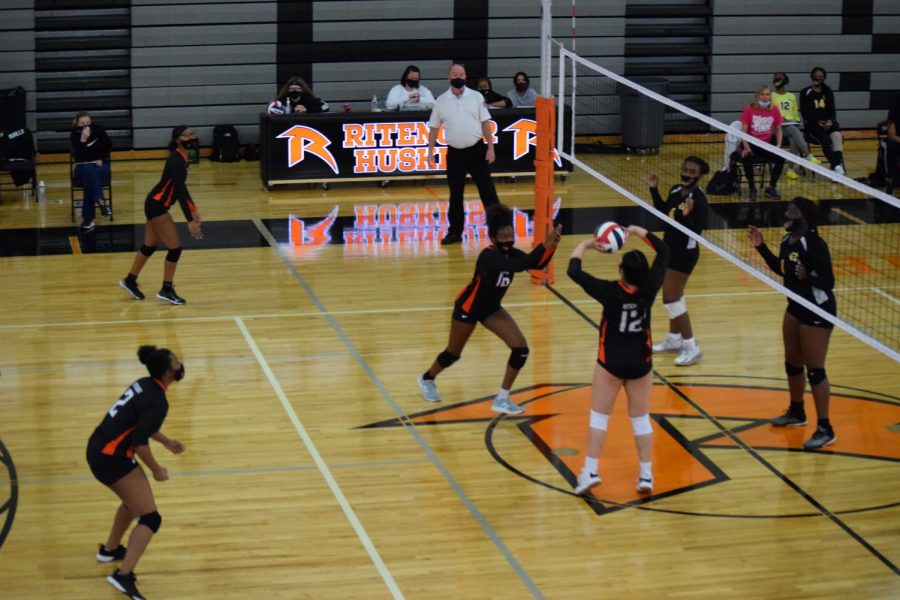A change over time
How women’s academic roles have changed during the history of Ritenour High School
Lee Laskowski
The girls volleyball team competes in a game in Costilow Fieldhouse during the 2021 season. As recently as 1981, the girls only played in the small gym while the boys hosted all of their games in the fieldhouse.
May 19, 2021
Throughout the last few decades, there have been frequent changes in women’s roles in education, at home, and at work. Many women throughout history have decided to break the ¨norms¨ and come out of their shells, and women’s roles both in and outside of education have changed significantly.
Ritenour has fit into this category of positive change. There are women from previous graduation classes who have experienced or helped in the change of women’s roles inside and out at Ritenour High School, and continue to do so today.
Over the last four decades, women’s sports have drastically changed. Sub Jeanne Sander, class of 1981, has been in the building as a student and recently as a substitute to experience it first hand.
¨(When I was in school), we had a girls’ gym and the boys got the Fieldhouse for gym and sports.¨ Sander said. ¨It wasn’t until my junior year that girls’ sports were moved to the Fieldhouse for varsity events. Prior to that, all girls sporting events took place in the small North Gym with an old clock and hardly any bleachers.¨
Now that Sander has seen these changes with sports, she still believes that while there is more opportunity and equity for female athletes, there could be more opportunities for female coaches.
¨As far as the roles women play, I do wish that there were more women involved in coaching. Although I know we have some excellent female coaches, I think it is good for everyone to see that women can coach both men’s and women’s sports.¨ Sander said.
Besides sports being a part of Ritenour High School. Our curriculum and the people who make it are important too. Cathy Nickens was a former teacher at RHS and has some knowledge regarding the system.
¨There are definitely more women in leadership positions in Ritenour today. I began my teaching career in the early 1970s and a woman was the chair for the Social Studies Department —unusual as the department was predominantly male,¨ Nickens said. ¨No women were in the administration at the secondary level at that time. In the late 1970s, a position for discipline was created for the administrative team at RHS. A talented PE teacher by the name of Faye Probus was appointed to primarily do the discipline for girls at RHS. That position was later eliminated and the first female assistant principal was hired in the mid-1980’s – Brenda Skillman who also graduated from RHS in 1968.¨
Outside of women becoming a part of the high school administration, women’s expectations for where they would go after high school were different too. In previous decades, there were a few different pathways that schools pushed their female students.
¨Prior to those changes which began in the 1970s, women primarily had limited choices in education. They could be teachers, nurses, or secretaries.¨ Nickens stated, ¨ Today, women in the district are even athletic trainers. I am so happy to see so many opportunities for all young women today to pursue in a school district like Ritenour.”
Sander also commented that there was a very specific pathway for female students when she was in high school in the early 1980s.
“Women were often in traditional roles still. There were boys taking shop and girls took home economics (now FACS). Girls never took shop class and boys never took home ec,” Sander said. “Many girls were directed to traditional women’s jobs such as secretarial, education, or nursing. I am proud that many women from my class though went on to do many other things. One of my friends is in charge of strategic planning at NASA and is in the Ritenour Hall of Fame.”
When it comes to what Ritenour High School needs in the future, there are still many different areas where there can be a focus for growth. With women’s roles primarily changing for the better, there are some more things women at RHS want to change. Laura Beamer is an alumnus from the class of 1996 and a current teacher in the English department. She has seen that change happen, just within classroom conversations.
¨When I was a senior I got a lot of that encouragement, but nothing like where we are today.¨ Beamer said, ¨We have a lot of conversations about how students feel, how the world is presented, and the pressures that they have. I would like to see more of that and more encouragement because there is a long way to go.”
Nationwide, there’s still not equal pay or the same level of opportunities. Teachers are trying to educate about these issues in order to move past them in the future.
¨There are a lot of groups that always don’t have the same chances. So, I would like to see a bigger push across the board for encouragement, support, and even activism,” Beamer said. “I think we should go even further with helping high school students learn how to use their voice. It benefits everybody. We are in transition, we came along but I think we can go further.¨
Women throughout Ritenour High School over time have made numerous changes inside and out of our sports, curriculum, and support within our community. These changes have made it for the better but there is also still room for improvement. Shedding light on women’s roles at Ritenour is only the first step for having a brighter future for women at the high school.
“There seems to be more equity among females and males now. There is also a bigger push for females to explore STEAM programs,” Sander said. “I do think sometimes there is still a stigma with girls not wanting to show off their intelligence because it might not be ‘cool.’ I think the college counselors have done a good job of showing girls that their career is not limited by their gender.”



